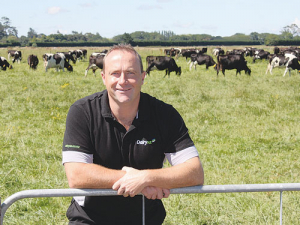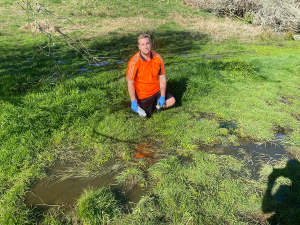Pasture was more profitable in years of lower payout and better weather, but feeding PKE came into its own with higher payout and poorer weather.
That appears to be an outcome of a three-year trial near Dargaville at the Northland Agricultural Research Farm run by the Northland Dairy Development Trust.
But DairyNZ principal scientist for animal science John Roche says the farm was getting a much higher response to PKE than is the average. And in all three seasons, the moderately stocked, pasture-only farmlet was profitable and could be managed without importing supplements from off-farm.
NARF farm manager Kate Reed and Northern Dairy Development Trust (NDDT) science manager Chris Boom explained in a summary to a recent field day that for three years the farm systems trial had been testing how two farms using all ‘home grown’ feed (grass-only farm and cropping farm) compare to a farm importing palm kernel expeller (PKE farm).
Stocking rate averaged 2.6 cows/ha on the grass-only farm and 2.8 cows/ha on the other two farms.
The first two years of the study showed that, taking into account the costs of supplementary feeding and cropping, a grass-only farm system may have similar or better profitability to a system using PKE.
However, the third season showed a significant advantage for the PKE farm due to a challenging late winter/spring having impacted the other farms to a greater extent. The use of cropping on heavy clay soils to replace imported supplements has not proved an effective strategy, the summary says.
The weather was relatively kind during the first two seasons, resulting in good pasture growth and pasture cover on all farms. The late winter and early spring of the third season was challenging due to prolonged wet conditions.
Pasture production totalled 17.4, 18.8 and 17.4 tonnes DM/ha for the 2015-16, 2016-17 and 2017-18 seasons respectively. None of these seasons had a prolonged summer/autumn dry.
Supplement use on the PKE farm was 469, 513 and 544kgDM PKE/cow for the three seasons respectively. Crops were grown on the cropping farm totalling 23%, 21% and 25% of the farm area for the three seasons respectively. Crops sown were turnips (average yield 8.4 t DM/ha), fodder beet (during the first two seasons only -- 15.6 t DM/ha) and maize silage (18.2 t DM/ha).
In the 2015-16 season, milk production was highest on the cropping farm at 1049kgMS/ha versus 870kgMS/ha on the grass-only and 1028kgMS/ha on the PKE farm.
For the 2016-17 season, production was highest on the PKE farm at 1118kgMS/ha versus 965kg and 1053kgMS/ha for the grass-only and cropping farms respectively.
The challenging spring during the 2017-18 season resulted in the cows on the grass-only and cropping farms being put on once-a-day milking, while the PKE farm continued through with twice-a-day milking. This gave the PKE farm a big advantage: it produced 1128kgMS/ha versus 893 and 887kgMS/ha on the grass-only and cropping farms respectively. Poor soil structure on ex-crop paddocks hampered the cropping farm.
Costs were calculated for each farm, including differential labour requirements. Over the three seasons, farm working expenses/kgMS averaged $3.97, $4.52 and $4.03 for the grass-only, cropping and PKE farms respectively. In 2015-16 with a $3.90/kgMS price, the grass-only farm had the highest operating profit at $787/ha followed by the PKE farm at $733/ha and the cropping farm at $433/ha.
For the 2016-17 season at a $6.12/kgMS price, the PKE farm had the highest operating profit at $2887/ha, followed by the grass-only farm at $2761/ha and the cropping farm at $2300/ha.
For the 2017-18 season at a forecast $6.55/kgMS the PKE farm again had the highest operating profit at $3224/ha versus the grass-only farm at $2470/ha and the cropping farm at $1928/ha.
The grass-only farm was the most profitable in the 2015-16 season, and the PKE farm was the most profitable for the 2016-17 and 2017-18 seasons.
These differences were due to changes in the milk price. If a constant milk price of $4/kgMS was used for all seasons, then the grass-only farm would have been the most profitable in the first two seasons. Likewise, if a $6/kgMS was used, then the PKE farm would have been most profitable in all seasons. The cropping farm was the least profitable in all seasons, though the difference was especially great in the third season when farm production took a hit due to the challenging spring.
In practice, more capital is required to develop infrastructure and machinery and to add cows for more intensive systems. Taking the extra capital requirement into account favours the grass-only farm which made it the most profitable during the first two seasons.
Profit versus loss
John Roche outlined the lessons learned from three years of research in Northland.
Marginal milk is the extra milk produced when supplements and/or crops are used to increase MS production per cow and/or per ha.
The profitability of supplementary feeds depends on the cost of this marginal milk. If the cost of marginal milk is less than the milk price, it’s profitable. If the cost of marginal milk is more than the milk price, it’s unprofitable.
The cost of marginal milk depends on: the milk production response to supplement; the price of the supplement; and any non-feed costs associated with the greater use of supplements (e.g., labour, fuel).
The average milk production response to PKE at NARF was very high: 126gMS/kg PKE DM (this ranged from 107 to 147gMS/kg PKE DM);
In comparison, the average response in DairyBase is ~80gMS/kg supplement DM;
Because of the high milk response to PKE, the cost of marginal milk at NARF was low: $5.30/kgMS (this ranged from $4.18 to $6.38);
A recent analysis of DairyBase reported the marginal cost of milk from increased use of supplementary feeds was $7.50 - $7.66 (Ma et al., 2018).


















